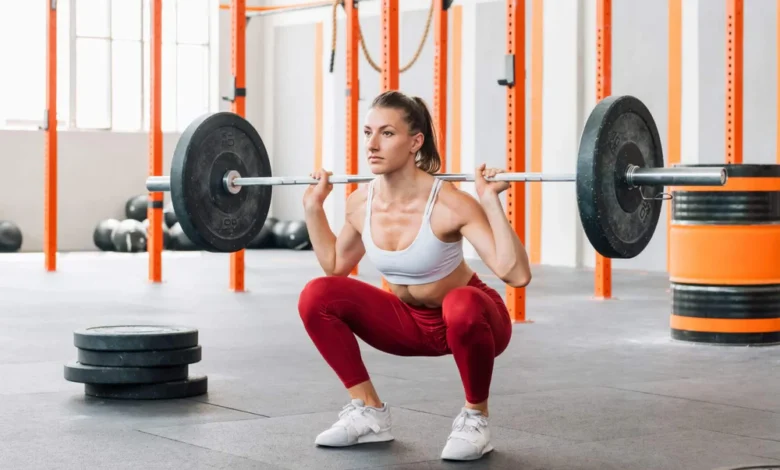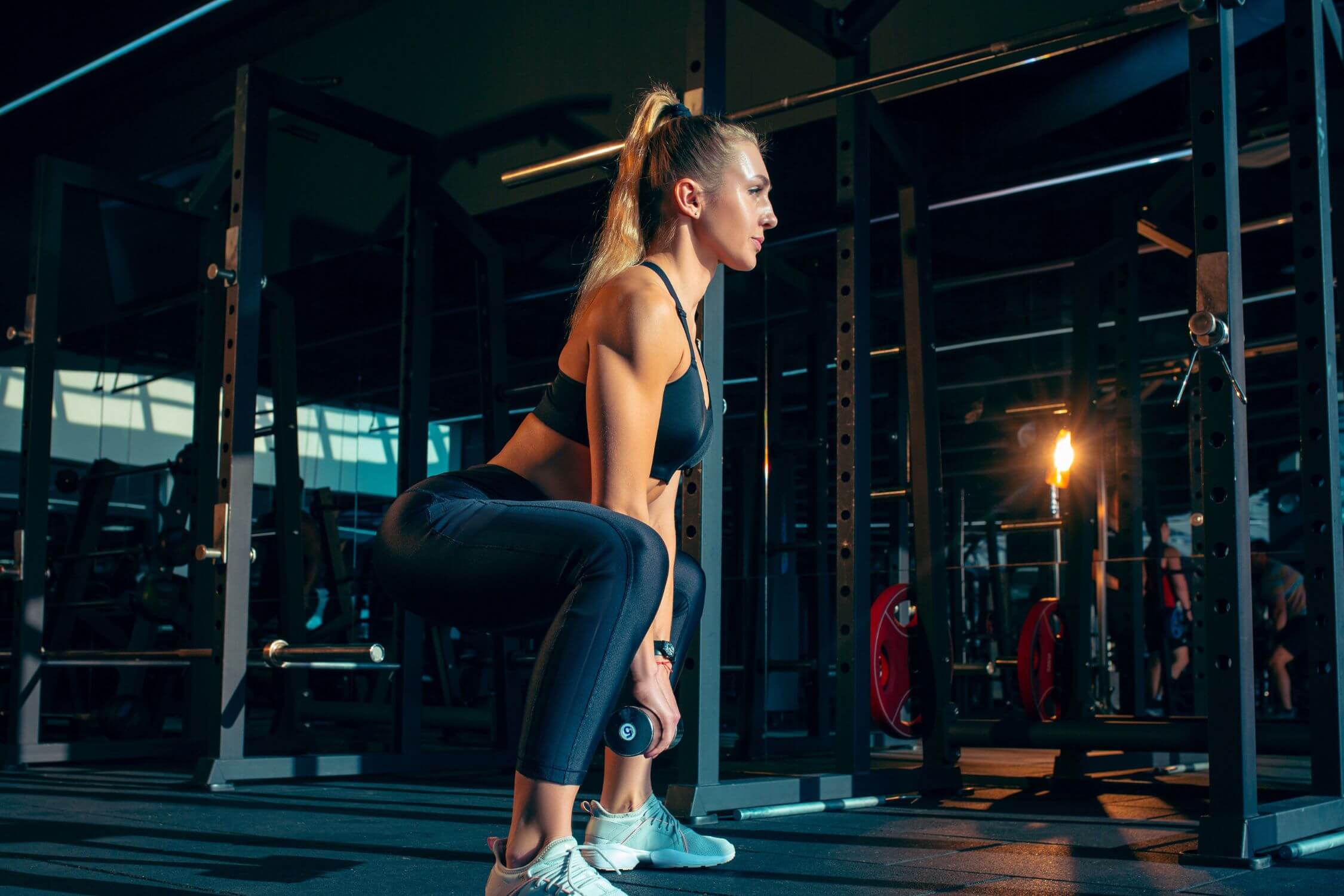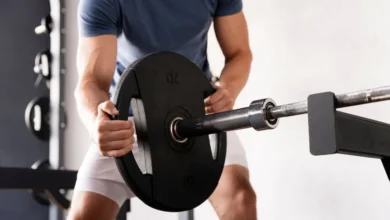Learning to Squat – The Correct Execution and Common Mistakes

The squat is a basic exercise in strength training – for the legs, buttocks, back and stomach. Sports enthusiasts do squats primarily to train their muscles. But they also train flexibility. The squat is considered the queen of exercises. It is therefore all the more worthwhile to take a closer look at this movement pattern from a biomechanical point of view.
Which muscles are trained?
The squat is considered a basic exercise in strength training because it uses the muscles of the entire body. It trains the lower half of the body, i.e. the legs and buttocks, but also the lower back and the rectus abdominis muscles.
Primary muscles: The primary muscles used are the quadriceps femoris, the biceps femoris and the gluteus maximus.
Supporting muscles: In addition, muscles such as the erector spinae, adductor and rectus abdominis muscles play a supporting role.
How should you perform a squat?
The squat is a knee-dominant movement, which means that our knees move forward. This knee advancement is accompanied by a vertical movement of the pelvis. The power comes primarily from the legs and buttocks. You also have to tense your abdominal muscles to counteract a hollow back and protect the spine. This is how to perform a squat step by step:
Step 1: The feet are at least shoulder-width apart, the weight is on the entire foot, the knees are slightly rotated outwards. The barbell is on the trapezius, i.e. on the shoulders rather than on the neck.
Step 2: Grip the dumbbell with your palms facing forward, your wrists straight, and your elbows under the dumbbell.
Step 3: Tighten your stomach, pull your shoulder blades back and down, and stretch your chest out.
Step 4: Breathe in deeply, build up pressure in the abdominal area, hold your breath and begin to bend your knees.
Step 5: Lower yourself slowly and in a controlled manner, with your knees always pointing towards your toes. Keep your upper body upright and try to move your pelvis up and down like an elevator.
Step 6: When you reach the bottom, stop briefly and then stand up again in a controlled manner, pushing off with your entire foot and exhaling forcefully through your mouth. In the lowest position, the knee angle is smaller than the hip angle. By pushing your knee forward, you lengthen the front thigh muscles and then strengthen them over a long range of motion.
Tip: Grab a short fitness band and place it on both legs slightly above knee height. This will help you maintain knee tension from time to time and prevent your knees from buckling.
How deep should you go?
There are numerous myths about this topic. For example, there is a recommendation circulating on the Internet that you should not squat deeper than 90°. This means that the squat should only be as deep as the thigh is parallel to the floor. However, this no longer corresponds to current knowledge.
In general, you should bend as low as possible, following the motto “Ass to the Grass”. The greatest pressure on the knee is achieved at around 90°. The lower you go, the less strain is placed on the knee joint.
If you can do a deep squat without pain and with a straight back, you should definitely do it that way. However, if you don’t have the necessary flexibility , you can improve here. Regularly train your flexibility in the deep squat and after just a few weeks you will be able to do the squat without pain and with a straight back.
Variation 1: Squat with heel raise
The biggest challenge when doing a squat is clearly managing your center of gravity, as many people’s center of gravity is more forward-facing. A heel raise can be a useful aid here. To do this, place your entire foot on a wedge with a raised heel.
Regarding the phases of the gait cycle, the heel raise takes us further back, i.e. onto the heel. This position is absolutely necessary for a squat. In this case, the heel raise helps us to bend deeper and vertically.
This removes ankle mobility as a limiting factor. The goal can be to reduce heel elevation over time, because simply performing squats with the help of such an elevation improves ankle mobility.
Variation 2: Goblet Squat
The popular goblet squat variation, where we hold a weight, such as a kettlebell or a weight bag, in front of us, increases the effect of the heel elevation and brings the body’s center of gravity further forward. This allows you to squat deeper.
To do this, stand with your feet hip-width apart and your toes pointing forward or slightly outward. Exhale for 6-10 seconds to lower your chest and get a good position between your pelvis, chest and head. Feel a slight tension in the oblique abdominal muscles, which you maintain while you continue to breathe normally. Your gaze is always directed forward. Your feet are firmly on the ground. Hold the kettlebell close to your body and push your elbows slightly forward, a so-called protraction of the shoulder blades. As you inhale, bend your knees and push them forward. Go down slowly, pause briefly at the lowest point and then go back up. Make sure that you do not fully extend your knees so that the muscle tension is maintained. When you inhale, put the pressure more on the heel and when you exhale, return to the starting position via the midfoot and forefoot.
Variation 3: Sumo Squat
In the sumo squat, the feet are one step wider than hip-width apart. The typical muscles of the squat variations are used, but the training stimulus for the inner thighs is significantly higher due to the wide position. Due to the higher level of difficulty, this fitness exercise is rarely seen in the gym .

Now start the exercise by bending both knees. Move your buttocks backwards and tilt your upper body slightly forwards. Your back remains straight throughout. Your arms with the kettlebell remain firmly fixed in front of your body. Continue the downward movement for as long as you can. When you reach the bottom, straighten your legs again and push your buttocks forwards in line with your body. Breathe out during the upward movement and do not stop until you are standing upright and your legs are almost completely straight.
Tip: Similar to the goblet squat, hold a weight in front of your body and push your elbows slightly forward.
5 most common mistakes in squats
#1 Lack of control of the body’s center of gravity: Controlling the body’s center of gravity is the biggest challenge, especially for beginners. One of the resulting mistakes is lifting the heel. Make sure that you keep the weight at the back for as long as possible in order to stabilize the body’s center of gravity in the middle.
#2 Too much movement in the pelvis: A common sight in the gym is too much movement in the pelvis. The pelvis moves horizontally backwards because the movement task cannot be solved otherwise. To avoid this, perform the exercise based on a knee-dominant movement pattern. The key to this is to place the trainee on a heel raise.
#3 Fear of straining the knees: When you start strength training, you want to protect your joints from injury as much as possible. The knee in particular is a key joint here. When you first start doing squat exercises, this fear can lead to the knees not being pushed forward. In this case, you should gradually try to increase the range of motion and establish the forward movement of the knees.
#4 Evasive movement when performing the movement: If you have already done squats, you will certainly have noticed that the pelvis tends to evade to the side when going up to the starting position. However, this is not a mistake, but rather a coping strategy for this exercise. Nevertheless, you should minimize this as much as possible.



